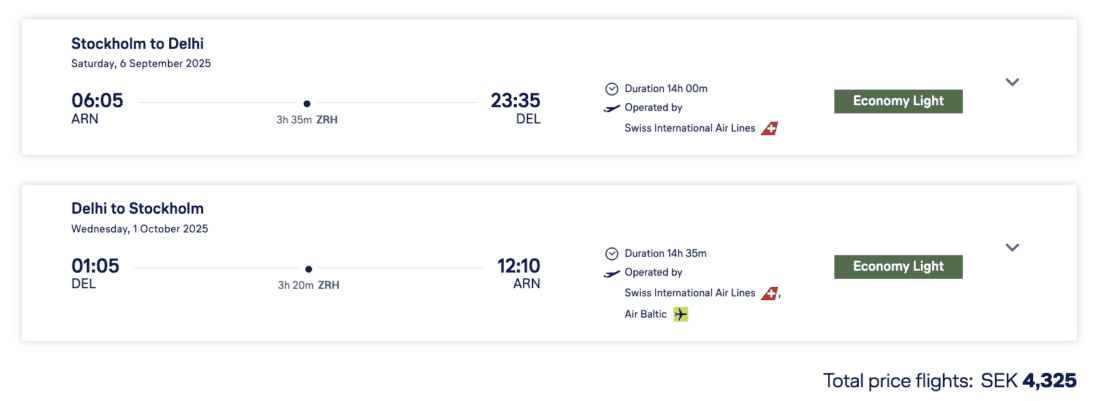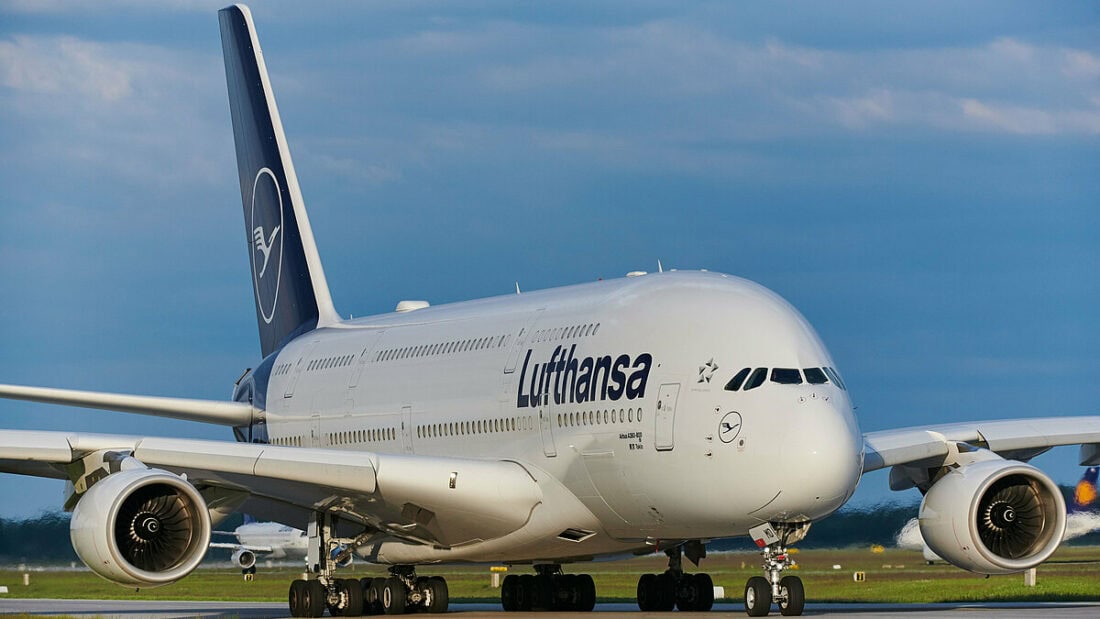Star Alliance members SWISS and Lufthansa are offering a deal from Scandinavia to Mumbai and Delhi starting at just €393. This deal does not include checked luggage, but you can add a 23 kg bag on Lufthansa’s website for roughly €60 from Sweden and Denmark, and around €40 from Norway. Departures are available from September to November.
You can fly from the following airports to Delhi:
- Stockholm at SEK 4,330 (~€396)
- Gothenburg at SEK 4,530 (~€414)
- Copenhagen at DKK 3,288 (~€440)
- Oslo at NOK 5,155 (~€437)
You can fly from the following airports to Mumbai:
- Gothenburg at SEK 4,495 (~€411)
- Stockholm at SEK 4,525 (~€414)
- Oslo at NOK 5,270 (~€447)
Our availability calendar highlights all possible flight dates at the lowest price for trips up to 28 days. It will forward you to Lufthansa with your selected flight dates.

If you fly with Swiss, an Airbus A330-300 will take you from Zurich to both destinations. You can also fly via Frankfurt or Munich. When changing planes in Frankfurt, a Lufthansa Airbus A340 will take you to Delhi and Mumbai. From Munich, you will fly on Lufthansa’s Airbus A380 to Delhi and the Airbus A350 to Mumbai.
European citizens require a tourist visa if they want to visit India. You can apply for it online at the official website. If you plan on continuing your journey on a separate ticket, you still need to apply for a tourist or transit visa.
Search & Book
This deal does not have an expiration date, but a minimum stay of ten days, and a maximum stay of twelve months apply. Departures are available from September to November
You can find suitable dates using our calendar above or with the help of Google Flights. We recommend booking directly on Lufthansa’s website, but you can find cheaper prices with Skyscanner. However, booking on OTAs has its downsides.
Why is booking with an airline better than with an online travel agency?
More often than not, online travel agencies offer lower fares than airlines do. We still recommend booking with the airlines directly. There are two main reasons for that:
Better Customer Service
In case any problems like delays, cancellations or missed connections arise, you can communicate directly with the airline. The airline has to take care of you because you have a contract with them.
If a travel agency issues your ticket, you may have to reach out to them first. You also depend on your OTA to forward information like flight changes instead of receiving them directly from the airline. In many cases, you may get a prime exhibition of responsibility shifting rather than problem-solving.
This especially applies to premium tickets. You don’t want to spend more than €1,000 to wind up with some budget OTA’s telephone hotline in case anything goes wrong.
Baggage and Other Fees
Economy fares not including hold luggage are industry standard by now. In most cases, travel agencies charge much higher baggage fees than the airlines themselves. If bags are not included in your fare, airlines are often the cheaper alternative.
This also applies to other things like food services, insurances or priority treatment. In almost all cases, you pay less for additional amenities when booking on the airlines’ website.
Miles & Points
This ticket is issued in booking class K. Here are the miles and points you can earn from this deal from Stockholm to Delhi with Lufthansa:
- 2,738 Miles on ANA Mileage Club
- 2,282 Award Miles + 456 PQP on United MileagePlus
- 2,282 Miles on ITA Volare
- 1,354 Award Miles + 160 Points on Miles&More
- Customize Calculation
If you fly with Swiss, here are the miles and points you can earn from this deal from Stockholm to Delhi:
- 2,846 Miles on ANA Mileage Club
- 2,372 Award Miles + 474 PQP on United MileagePlus
- 2,372 Miles on Turkish Airlines Miles&Smiles
- 2,372 Miles on Ethiopian ShebaMiles
- 2,372 Miles on Egyptair Plus
- 2,372 Miles on ITA Volare
- 1,354 Award Miles + 160 Points on Miles&More
- Customize Calculation
Destination
Information & Tips for India
India is a large and diverse country with major tourist sights like the Taj Mahal in Agra, the forts and palaces of Rajasthan, the backwaters of Kerala, and spiritual cities like Varanasi and Rishikesh. The currency used is the Indian Rupee (INR). Prices vary widely—budget travel is possible, but mid-range and luxury options are also common, especially in tourist-heavy areas. Weather depends heavily on region and season: winters (Nov–Feb) are generally pleasant, while summers (Mar–June) can be extremely hot, and the monsoon (June–Sept) brings heavy rainfall in many parts.
India’s transport infrastructure is a mix of modern and outdated systems. Within cities, getting around can be chaotic but manageable—options include auto-rickshaws, taxis, metro systems in larger cities like Delhi and Mumbai, and app-based services like Uber and Ola. Between cities, India has an extensive railway network that’s affordable but often crowded and prone to delays; domestic flights are common and relatively inexpensive for longer distances. Roads connect most places, but traffic and conditions can be unpredictable.
We’ve compared various eSIM providers, such as eSIM4Travel and SimOptions. To see which plan is best for your travel needs and which network offers the best coverage, feel free to read our detailed guide:
The Best eSIM Plans for India 🇮🇳 Compared
→ All Dealz for India
Information & Tips for Mumbai
Mumbai, India’s financial and cultural hub, offers attractions like the Gateway of India, Marine Drive, and the Elephanta Caves. The local currency is the Indian rupee (INR), and credit cards are widely accepted, though cash is still commonly used. The price level can vary, with affordable street food and budget accommodations, but higher-end restaurants and hotels can be expensive. Mumbai’s weather is typically hot and humid, with a monsoon season from June to September and a cooler, more pleasant climate from November to February, which is ideal for visiting.
→ All Dealz for Mumbai
Information & Tips for Delhi
Delhi, India’s capital, is known for historic sites like the Red Fort, Humayun’s Tomb, and Qutub Minar, as well as vibrant markets and cultural districts. The local currency is the Indian rupee (INR), and cash is widely used, though cards and digital payments are increasingly common. Prices are generally low by international standards, making it a budget-friendly destination. The weather is extreme—very hot in summer (April–June), with a monsoon season from July to September, and cooler, more comfortable weather from October to March.
→ All Dealz for Delhi
Cover Picture: © Lufthansa Group
